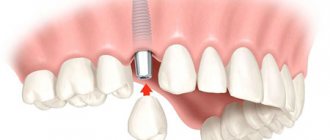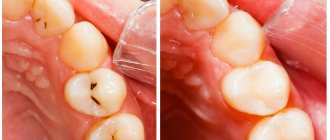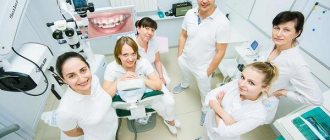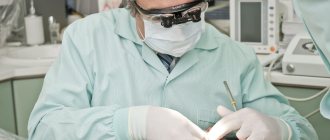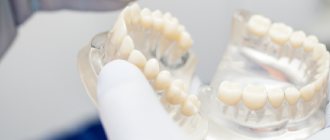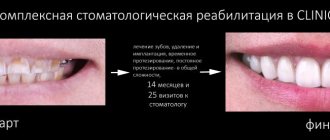Author: ProfGid
A prosthetic dentist or orthopedic dentist is a specialist who is approached for artificial reconstruction of teeth when there is no way to cure and preserve them. Thanks to modern technologies, such a doctor can restore oral health and a beautiful smile to any patient. The profession belongs to the category “ person – person ”. By the way, in 2022, the ProfGid career guidance center developed an accurate career guidance test. He himself will tell you which professions are suitable for you, and give an opinion about your personality type and intelligence.
Short description
An orthopedic dentist first receives a general dental education and then studies his future specialization in depth. He is responsible for all stages of selection, preparation and installation of dentures in their modern variations. This is one of the most sought-after dental profiles on the labor market, as it allows both to restore full functionality of the jaw and to give the patient a beautiful smile.
What determines the cost of services?
The cost of treatment by an orthopedist will depend on several factors:
- Choice of methodology .
The most expensive today is considered to be implantation with fixation of a zirconium dioxide crown. The cost of the service in this case will start from 15 thousand rubles. The most affordable treatment option is the installation of a crown or bridge, the price of which starts from 5 thousand rubles. - Workload . The more destroyed units need to be restored, the more material will be needed to make structures. For example, the same bridge for one tooth will cost from 5 thousand rubles, and for two crowns, the cost will increase to 8 thousand rubles.
- Material of manufacture . When using expensive materials, the final cost of the product and service will be significantly higher than when using cheap options. So, a metal crown will cost 1,500 rubles, while the cost of a ceramic one starts from 6 thousand rubles.
Orthodontic treatment is a mandatory procedure for edentia, which will not only restore the aesthetics of the smile, but also normalize the natural functionality of the dentition.
Average prices
The cost of services of a specialist in this area is determined by several main factors:
- The method chosen for the work. Implantation using fixation of zirconium dioxide crown is the most expensive. The average cost of such services today is set at 15,000 rubles .
- The total amount of work performed. Depending on the volume of dental units being restored, the total cost of the work is determined. In this case, the cost of manufacturing and installing a bridge varies from 5,000 to 8,500 rubles.
- Material used in manufacturing. The cost of the material is the determining factor in setting the price of the product. A metal crown can cost 1,500 rubles , while a ceramic crown will cost 6,000 or more.
Features of the profession
Not every person manages to keep their teeth healthy throughout their life. However, many technologies and materials for dental prosthetics can effectively solve this problem. And if decades ago dentures did not look very beautiful and did not always take root, modern technologies significantly reduce the risk of implant rejection and make it possible to give the dentition an aesthetic, natural look. A prosthetic dentist is fluent in all methods of restoring lost teeth, and his main job responsibilities are as follows:
- examination of the patient, collection of anamnestic data, selection of prosthetic methods suitable for a specific individual case, counseling the patient;
- taking dental impressions;
- production of prostheses from modern materials using high-tech equipment;
- installation of pins in the patient’s jaw, fitting of dentures;
- temporary installation of dentures, correction of detected imperfections;
- securing prostheses for permanent wear.
Dentures can be removable, fixed, conditionally removable, these can be implants, bridges, inlays, crowns. Some technologies gradually cease to be used, and they are replaced by new, more advanced ones. But, in any case, only a professional prosthetist dentist can choose the optimal option for any patient with impaired chewing function or complaints of cosmetic defects in the dentition.
Preparing for an appointment and how to see a doctor
It is not recommended to drink alcohol before seeing a specialist. The presence of alcohol in the patient's blood negatively affects the effect of anesthetic drugs. If the patient is sick, then you should postpone your visit for a while. Before coming to the dental office, you should thoroughly brush your teeth. Therefore, it is advisable to discuss the time of your appointment with the dentist in advance.
At the first consultation, the doctor must determine the degree of damage to the patient’s masticatory apparatus. Before starting orthopedic treatment, complex surgical and therapeutic treatment of the oral cavity is carried out. This makes it possible to carefully prepare the soft and hard tissues of the patient’s maxillofacial area for upcoming procedures. Treatment of the following diseases is mandatory:
- Pulpitis,
- Caries,
- Scar changes in the mucous membrane,
- Stomatitis, gingivitis, periodontitis.
During the appointment, the orthopedic dentist examines the patient’s oral cavity and listens to complaints. The inspection can be visual and instrumental. Next, the doctor takes impressions and photographs the dentition. If necessary, a consultation with a dental surgeon is scheduled. Based on the data obtained, the doctor draws up a further treatment plan for the patient.
First appointment with an orthopedist
Patients are often interested in how the first examination by an orthopedist goes in order to have a rough idea about it, so we will identify the main points that accompany the first appointment with the specialist in question:
- visual assessment of the anatomical structure relevant to the skeletal system (correctness or irregularity), this action is especially important in the case of examining a newborn child;
- determining the range of motion relevant to the affected joints;
- appointment of fluoroscopy, on the basis of which the alleged diagnosis can be clarified or refuted;
- complex forms of pathology may indicate the need for such research methods as CT and MRI (which, respectively, defines computed tomography or magnetic resonance imaging).
Tests prescribed by an orthopedist
Despite the profile of this specialist, which, as one might mistakenly assume, excludes tests as a necessity to complement the overall picture of the disease, one cannot do without their traditional and specific forms here. In particular, the orthopedist may need the results of the following tests:
- general analysis of urine and blood;
- data regarding blood clotting time;
- data on activated partial thromboplastin time;
- prothrombin index, as well as prothrombin time and prothrombin time + fibrinogen.
Advantages and disadvantages
pros
- A prestigious, in-demand profession.
- High salary level.
- Possibility of retraining in related areas of psychology.
- The opportunity to see the real result of your work.
Minuses
- The need to work with the dental cavities of different patients and, as a result, the need for the absence of disgust.
- The need to constantly monitor the development of new technologies and news from the world of dentistry.
- Quite a high level of requirements for specialists.
Diagnostic measures
An orthopedic dentist uses the following diagnostic methods.
- Interviewing the patient and collecting anamnesis.
- Examination of the face. The size of the mouth gap, shortening of the lower area of the face, its asymmetry (if any), position of the chin and lips are recorded. Palpation is used to check the tone of the labial muscles.
- Inspection of PR. The shape, size and number of teeth, and bite are studied in detail. The condition of the mucous membrane, the peculiarities of the formation of the frenulum of the lips, the range of movements and the shape of the tongue, the morphology of the vault of the hard palate, and the development of the jaws are assessed. Attention is focused on the functionality of the TMJ when working the lower jaw.
Using radiography, the condition of the supporting units, the presence of impacted and rudiments of permanent elements is determined.
As additional methods, special studies of the functions of the jaw apparatus may be prescribed:
- Functional chewing tests.
- Condition of nasal breathing (rhinoscopy, rhinopneumometry, rhinomanometry).
- Dimensions, shapes, position and functionality of the tongue (teleradiography).
- The relationship of the parts of the skull relative to each other (cephalometry).
Based on the examination results, a diagnosis is made and orthopedic treatment tactics are developed.
Important personal qualities
A prosthetist dentist is required to be responsible, attentive, collected, focused, and patient. In terms of the level of attention to detail required, his work is close to that of jewelry; making mistakes and carelessness in it is unacceptable (especially considering the high cost of consumables). In addition, like any doctor, such a dentist must have certain empathy abilities, a desire to help people, and the ability to find a common language with them. He should also be characterized by a desire for constant development and self-improvement.
Training to become a prosthetist dentist
In order to have the opportunity to immerse yourself in this profession, you must obtain a higher medical education in the general profile of “Dentistry” ( specialty code - 05/31/03 ). To do this, you need to take the Unified State Exam in the Russian language, chemistry and biology or physics (each university sets the exact list of disciplines individually).
Training is most often carried out in a full-time format; some universities offer part-time and part-time education. It lasts 5-6 years, after which you will need to complete a residency in your specialization to gain deeper practical skills, knowledge and abilities.
Career
in the same position throughout his work history , but, as his skills improve (and move to different clinics), his income increases. Or he can become the head of the department, then, after some time, receive the position of deputy chief physician of the clinic, and then become the chief physician . A faster option for this career advancement has already been mentioned - this is opening your own medical institution, but it will require financial investments and the solution of many organizational issues. With a focus on research and development, an orthopedic dentist can become a candidate, and then a doctor of science .
Dental technician's office
The dental table is the main place of work. It is usually equipped with a lamp, a jet nozzle that is used to blow on the work surface, a suction funnel, sometimes a built-in socket for the grinding motor, and, of course, a chair.
Specialization
Often a dental technician makes a certain type of denture and improves in its manufacture. Therefore, there is a division in the profession in the following areas:
- Metal-ceramist (fixed prosthetics). Works with artificial material, which is an alloy of metals and ceramics. Such designs are characterized by wear resistance, resistance to corrosion and heat. A metal-ceramic prosthesis is a metal frame coated with ceramic mass.
- CAD/CAM system operator. A specialist in this field must have a good understanding of the modeling and milling processes.
- Prosthetics on implants . The essence of the method is that an implant is implanted into the jawbone tissue, which replaces the lost tooth root and serves as a support for an artificial tooth.
- Removable prosthetics . It can be complete, when the dentition of one or both jaws is completely absent, or partial, worn in place of one or more lost teeth.
- Orthodontic devices. Designs for aligning the dentition.
By process, the work is also divided into: casting metals and polymers, plaster casting into an articulator, modeling prosthetic frames, casting models. Thus, from two to fifteen people work together to produce one prosthesis in a dental laboratory.
